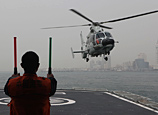
Composed of command organs at all levels and radars under their control, computers as well as communication facilities, the command and control sub-system is responsible for collecting and processing air intelligence, mastering development of air situations, judging the nature of targets, selecting operation plans, and commanding and guiding air combat.
The aerial defense and ground air defense sub-systems are tasked with intercepting and interfering with the enemy's air raid weapons based on the operation plans and data provided by the command and control sub-system.
The integrated support sub-system is responsible for ensuring the survival and completion of the aforementioned sub-systems and missions, while the civil air defense sub-system organizes personnel and materials for protection, firefighting, medical care and other work.
The white paper made public the Chinese army's combat readiness for the first time, saying that combat readiness refers to preparations of the armed forces for undertaking operational tasks and military operations other than war (MOOTW), and it is the general, comprehensive and regular work of the armed forces.
Based on different tasks, troops assume different levels of readiness (Level III, Level II and Level I, from the lowest degree of alertness to the highest).
The white paper said the PLAAF focuses its daily combat readiness on territorial air defense. It follows the principles of applicability in both peacetime and wartime, all-dimension response and full territorial reach, and maintains a vigilant and efficient combat readiness.
PLAAF organizes air alert patrols on a regular basis to verify abnormal and unidentified air situations promptly. The PLAAF command alert system takes PLAAF command posts as the core, field command posts as the basis, and aviation and ground air defense forces on combat duty as the pillar.




















![]()
